| Article ID | Journal | Published Year | Pages | File Type |
|---|---|---|---|---|
| 8083155 | Journal of Environmental Radioactivity | 2014 | 17 Pages |
Abstract
Observations made in April 2013 of the radioxenon isotopes 133Xe and 131mXe at measurement stations in Japan and Russia, belonging to the International Monitoring System for verification of the Comprehensive Nuclear-Test-Ban Treaty, are unique with respect to the measurement history of these stations. Comparison of measured data with calculated isotopic ratios as well as analysis using atmospheric transport modeling indicate that it is likely that the xenon measured was created in the underground nuclear test conducted by North Korea on February 12, 2013, and released 7-8 weeks later. More than one release is required to explain all observations. The 131mXe source terms for each release were calculated to 0.7Â TBq, corresponding to about 1-10% of the total xenon inventory for a 10Â kt explosion, depending on fractionation and release scenario. The observed ratios could not be used to obtain any information regarding the fissile material that was used in the test.
Keywords
Related Topics
Physical Sciences and Engineering
Energy
Nuclear Energy and Engineering
Authors
A. Ringbom, A. Axelsson, M. Aldener, M. Auer, T.W. Bowyer, T. Fritioff, I. Hoffman, K. Khrustalev, M. Nikkinen, V. Popov, Y. Popov, K. Ungar, G. Wotawa,
